Mini Class; " Multiplication Using The Column Form"
We are exposed to multiplication from an early stage in school; some schools even teach their pupils citation of multiplication by drafting a multiplication table that contains numbers 1-20. But in a situation we are asked to multiply a bigger number by a bigger number, for Example 5234×513; what technique can we use to have the solution within seconds? Using the column form of calculation will hasten up the process. In this post, I will practically share this method of solving multiplication with you. But before then, there are two Jargon in multiplication you need to be conversant with; they are multiplicand and multiplier.
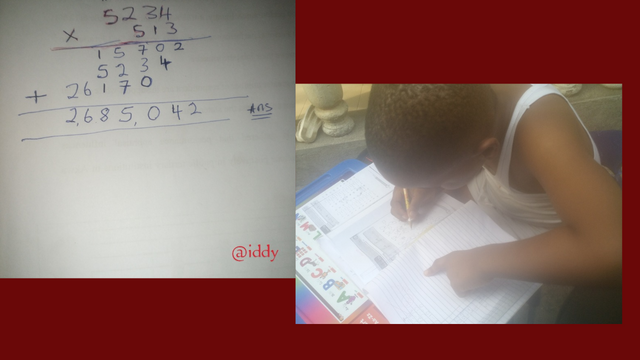
Created with canva
MULTIPLICAND AND MULTIPLIER
MULTIPLICAND: Simply put, these are numbers that are to be multiplied by another number. For example, in the problem 5234×513, the MULTIPLICAND is 5234.
MULTIPLIERS: Simply put, these are numbers that are used to multiply other numbers (MULTIPLICAND). For example, in the problem 5234×513, the multiplier is 513.
Having this requisite knowledge will aid our deeper understanding of multiplication using column form. Therefore, let's move to the practical part of multiplication using column form.
MULTIPLICATION USING COLUMN FORM
In this form of multiplication, we arrange the multiplicand and the multiplier in a column format. Let's still use the earliest problem which was 5234×513. In the image below, you will see how the problem is rearranged in a column format.
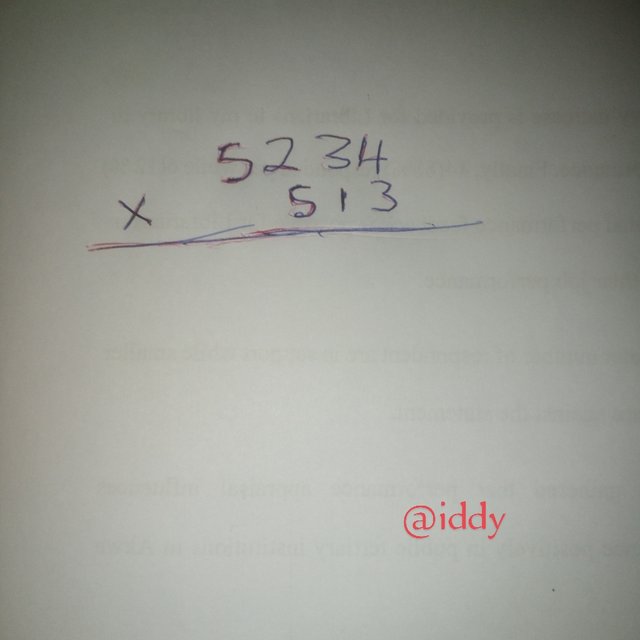
Column format
From the image above, you will notice that we began the rearranging of the multiplicand and multiplier from unit to thousand. See the image below to fully comprehend what we mean by unit, tenth, hundredth, and thousand, where U, T, H, and TH Represent unit, tenth, hundredth, and thousand, respectively.
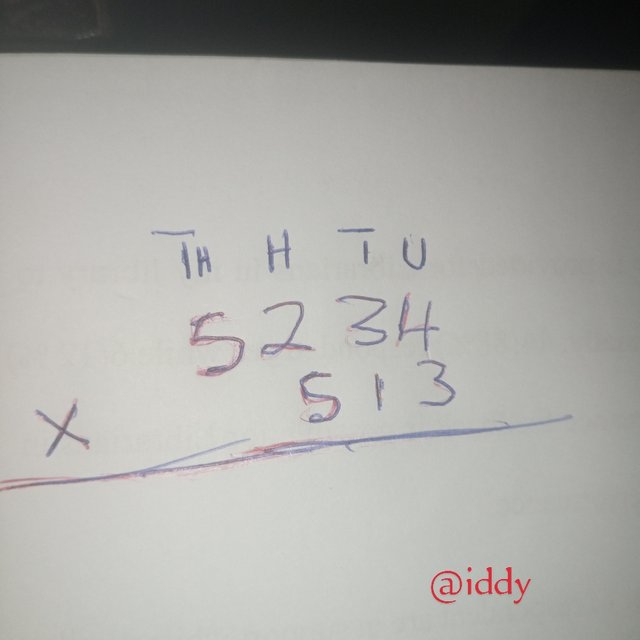
Let's now solve the problem.
SOLUTION
To solve the problem, begin the multiplication from the unit to a thousand, using the multiplier. Watch out for the steps to solving the problem as indicated below;
STEP 1: Use the unit of the multiplier, which is 3, to multiply the multiplicand starting from its unit, which is 4, to thousand, which is 5. See the solution in the image below;
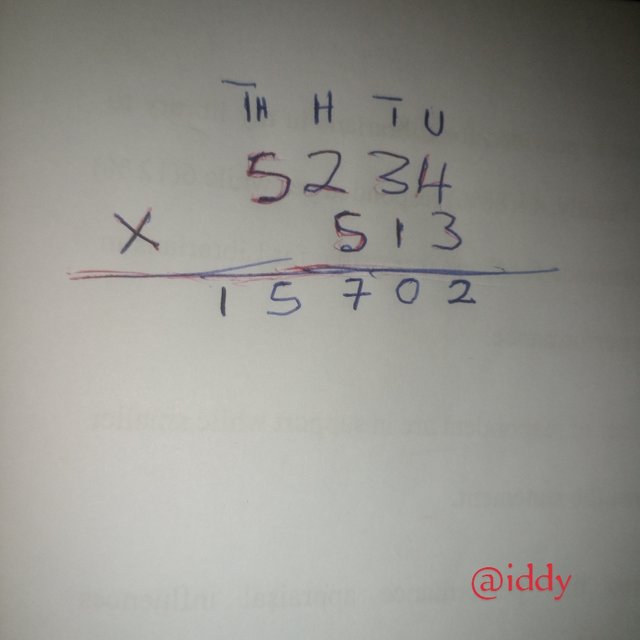
Note: from the image;
- 3×4=12. But we keep 2 and carry forward 1 to the next column
- 3×3=9. But we added the 1 that was brought forward from the preceding column to have 10, then we kept 0 and carried forward 1 to the next column
- 3×2=6. But we added 1 that was brought forward from the preceding column to have 7
- 3×5=15
STEP 2: In this step, we use a tenth of the multiplier, which is 1, to multiply the multiplicand from its unit to its thousand. But note we began dropping our answer from the very column of the tenth that 1 is on. See the image below;
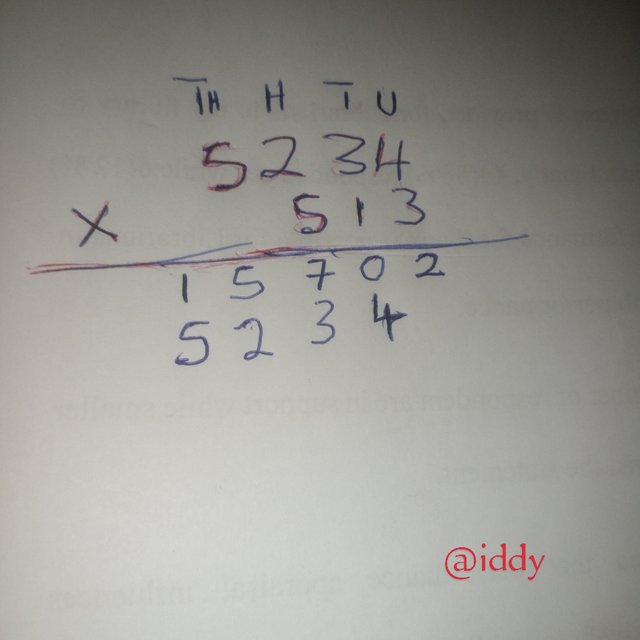
Note: From the image above, since the multiplier in this context is 1, our answer remains the same from the unit to thousand of the multiplicand.
STEP 3: In this step, we use the hundredth of the multiplier, which is 5, to multiply multiplicand, from its unit to its thousand. Note we begin to drop our answer from the column of the hundredth that 5 is on. See the image below;
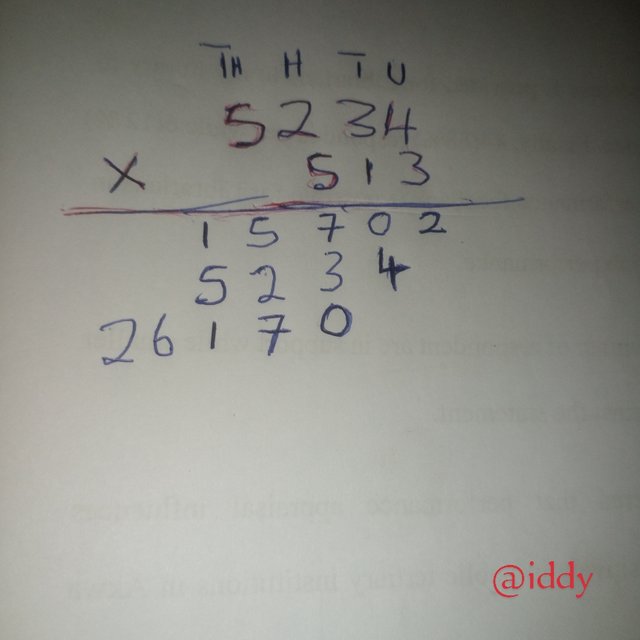
Note: From the above image;
- 5×4=20. But we kept 0 and brought forward 2 to the next column
- 5×3=15. But we added 2 we brought forward to have 17, then we kept 7 and brought forward 1 to the next column.
- 5×2=10. But we added the 1 we brought forward to have 11, then we kept 1 and brought forward 1 to the next column.
- 5×5=25. But we. Added the 1 we brought forward to have 26.
STEP 4: In step 4, we add the answers we have by column from the right-hand side. See the image below;
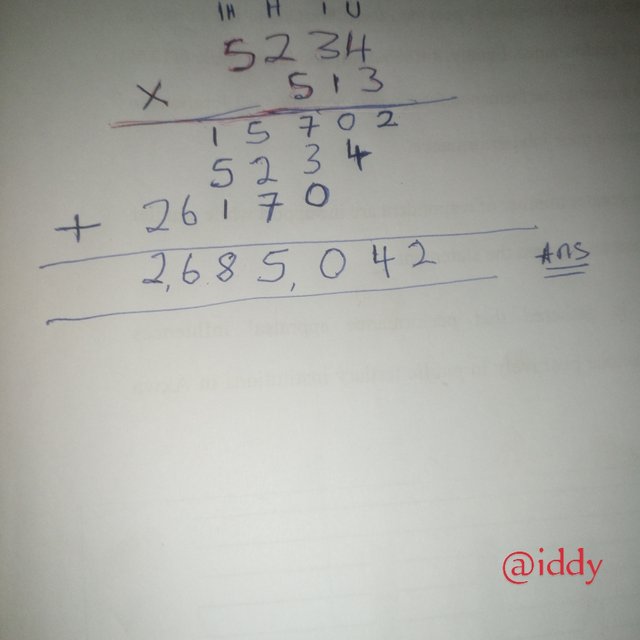
Note: From the Image above;
- starting from the right-hand side to add by column. In the 1st column, we have 2
- in the second column; 0+4=4
- in the 3rd column; 7+3+0=10. But we kept 0 and carried forward 1 to the next column
- in the fourth column, 5+2+7 + the 1 that was brought forward equals 15. But we kept 5 and brought forward 1
- in the fifth column, 1+5+1 + the 1 that was brought forward equals 8
- in the sixth column, we have 6
- in the seventh column, we have 2
Therefore the solution to the problem is 2,685,042
Conclusively, the column form of multiplication
Is an effective way of finding a solution to a problem involving multiplication. It's efficient and fast.
Our young ones on the platform, I hope you have learned something from this post. Our parents who are not mathematics-inclined, I hope you have learned something that will enable you to help your kids with their mathematics assignments.
Thank you very much.
Best regards
@iddy
X-shared:
https://x.com/iddy_e_okon/status/1882825780029481183
Upvoted! Thank you for supporting witness @jswit.
We support quality posts and good comments Published in any community and any tag.
Curated by : @edgargonzalez
Thank you very much, @edgargonzalez, for the support.
Thank you for publishing an article in the Steem Kids & Parent community today. We have assessed your entry and we present the result of our assessment below.
MODs Comment/Recommendation:
We are exposed to guna from the early stages in school; Some schools even teach their students multiplication tables by creating a multiplication table containing the numbers 1-20.
A great creativity
Remember to always share your post on Twitter. This POST LINK is a guide to that effect.
Thank you very much for the verification